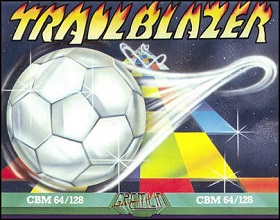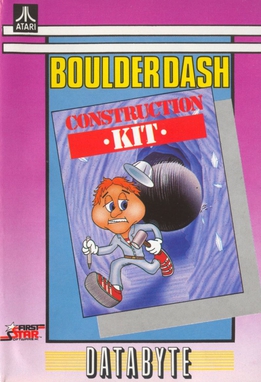
The Commodore 64, also known as the C64, is an 8-bit home computer introduced in January 1982 by Commodore International. It has been listed in the Guinness World Records as the highest-selling single computer model of all time, with independent estimates placing the number sold between 12.5 and 17 million units. Volume production started in early 1982, marketing in August for US$595. Preceded by the VIC-20 and Commodore PET, the C64 took its name from its 64 kilobytes(65,536 bytes) of RAM. With support for multicolor sprites and a custom chip for waveform generation, the C64 could create superior visuals and audio compared to systems without such custom hardware.

Arkanoid is a 1986 block breaker arcade game developed and published by Taito. In North America, it was published by Romstar. Controlling a paddle-like craft known as the Vaus, the player is tasked with clearing a formation of colorful blocks by deflecting a ball towards it without letting the ball leave the bottom edge of the playfield. Some blocks contain power-ups that have various effects, such as increasing the length of the Vaus, creating several additional balls, or equipping the Vaus with cannons. Other blocks may be indestructible or require multiple hits to break.

Deluxe Paint, often referred to as DPaint, is a bitmap graphics editor created by Dan Silva for Electronic Arts and published for the then-new Amiga 1000 in November 1985. A series of updated versions followed, some of which were ported to other platforms. An MS-DOS release with support for the 256 color VGA standard became popular for creating pixel graphics in video games in the 1990s.

The Computer History Museum (CHM) is a museum of computer history, located in Mountain View, California. The museum presents stories and artifacts of Silicon Valley and the information age, and explores the computing revolution and its impact on society.

Trailblazer is a racing video game developed by Mr. Chip Software and published by Gremlin Graphics for the ZX Spectrum, Commodore 64, Atari 8-bit family, Amstrad CPC and Commodore 16/Plus/4 in 1986. It was ported to the Amiga and Atari ST.

8 Bit Weapon is an American chiptune music band formed in Ventura County, California, by Seth and Michelle Sternberger. It was originally created by Seth Sternberger around 1998. Its instruments consists primarily of old 8-bit and 16-bit computers such as the VIC-20, Commodore 64, Commodore 128, Amiga 500, and the Apple II, as well as game consoles such as the Nintendo Entertainment System, Game Boy, Atari 2600, and an Intellivision synthesizer.
The Amiga is a family of home computers that were designed and sold by the Amiga Corporation from 1985 to 1994.

A computer museum is devoted to the study of historic computer hardware and software, where a "museum" is a "permanent institution in the service of society and of its development, open to the public, which acquires, conserves, researches, communicates, and exhibits the tangible and intangible heritage of humanity and its environment, for the purposes of education, study, and enjoyment", as defined by the International Council of Museums.
Datasoft, Inc. was a software developer and publisher for home computers founded in 1980 by Pat Ketchum and based out of Chatsworth, California. Datasoft primarily published video games, including home ports of arcade games, games based on licenses from movies and TV shows, and original games. Like competitor Synapse Software, the company also published other software: development tools, word processors, and utilities. Text Wizard, written by William Robinson and published by Datasoft when he was 16, was the basis for AtariWriter. Datasoft initially targeted the Atari 8-bit family, Apple II, and TRS-80 Color Computer, then later the Commodore 64, IBM PC, Atari ST, and Amiga. Starting in 1983, a line of lower cost software was published under the name Gentry Software.

Escape from Singe's Castle, also known as Dragon's Lair Part II - Escape From Singe's Castle, is a computer game for the Amstrad CPC, Commodore 64 and ZX Spectrum home computers, released by Software Projects in 1987.

Test Drive is a racing video game developed by Distinctive Software and published by Accolade, released in 1987 for the Amiga, Atari ST, Commodore 64, and DOS, in 1988 for the Apple II, and later ported for the PC-98 in 1989. It is the first game in the Test Drive series.

Shanghai is a computerized version of mahjong solitaire published by Activision in 1986 for the Amiga, Atari ST, Atari 8-bit family, Commodore 64, DOS, Macintosh, Apple IIGS and Master System. Shanghai was originally programmed by Brodie Lockard. It was released as an arcade game by Sunsoft in 1988.

Home computers were a class of microcomputers that entered the market in 1977 and became common during the 1980s. They were marketed to consumers as affordable and accessible computers that, for the first time, were intended for the use of a single, non-technical user. These computers were a distinct market segment that typically cost much less than business, scientific, or engineering-oriented computers of the time, such as those running CP/M or the IBM PC, and were generally less powerful in terms of memory and expandability. However, a home computer often had better graphics and sound than contemporary business computers. Their most common uses were word processing, playing video games, and programming.

Boulder Dash Construction Kit is the fourth game in the Boulder Dash series. It published for the Commodore 64 and Atari 8-bit family in 1986 by Epyx. Ports were released for the Apple II, Atari ST, Amiga, Amstrad CPC, ZX Spectrum, and MS-DOS. The Spectrum version was rereleased as Boulder Dash IV: The Game. Boulder Dash Construction Kit includes new levels and a level editor.

The Computerspielemuseum is a video game museum founded in 1997. From 1997 to 2000, it had a permanent exhibition in Berlin. Afterward, it became an online-only museum. In 2011, the museum reopened its permanent exhibition in Berlin's neighborhood of Friedrichshain, on Karl-Marx-Allee. During the first month of its permanent exhibition, it had 12,000 visitors.

The Nexon Computer Museum is a museum on Jeju Island, South Korea. It opened on July 27, 2013. It is known as one of the first permanent museum in Korea that is dedicated for the history of computer and video games. As of 2017, the museum houses 6,900 items including personal computers, video game consoles, arcades, and software. The museum's supporters include institutions such as Computerspielemuseum Berlin and International Center for the History of Electronic Games, and IT companies such as Nexon, Softmax, Gamevil, Oculus VR, Thalmic Labs, Take-Two Interactive, Sony Computer Entertainment, etc. The principle of Nexon Co. Ltd.'s museum is to interact and communicate with a range of visitors from across boundaries, by collecting, preserving, researching, exhibiting and educating historic digital artifacts.

World of Commodore is an annual computer expo dedicated to Commodore computers.

Ports of Call is a 1986 business simulation game developed by German duo Rolf-Dieter Klein and Martin Ulrich, and published by Aegis Interactive Entertainment. It was initially released for AmigaOS. After a subsequent early release for DOS it was also made available to a number of different platforms over the years, including Windows, iOS, Android and as a browser game.

















